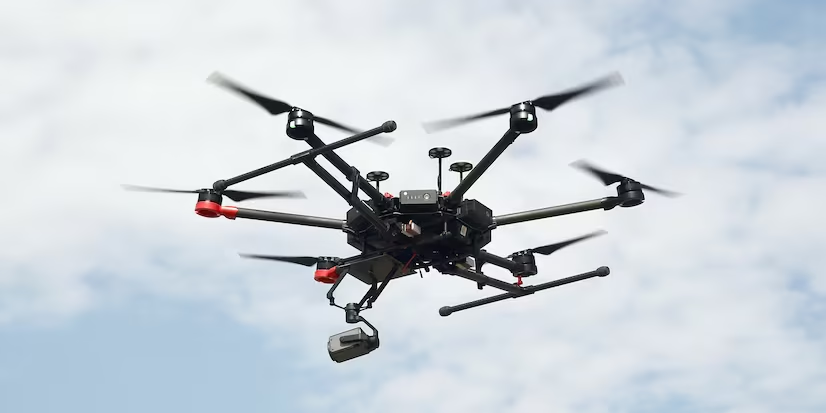Dr. Compesh Pannu, Researcher
India is standing on the cusp of major change, which can be summed up in one line: Entrepreneurship in India. Entrepreneurship is highly admired, appreciated and encouraged in the present scenario. There are numerous types of business ideas that are flourishing in India today, one of the most promising ones being Drone technology. Unmanned Aerial Vehicles (UAV) commonly referred to as drones are a type of aircraft that can fly without presence of a human pilot, crew or passengers on board. Drones offer tremendous benefits to almost all sectors of the economy. Some real world applications of drones are
- Agriculture
Drones are used in agricultural farms to monitor activities such as weather, crop health, soil conditions (e.g. temperature), pest control, etc. Drones can help farmers to regularly monitor several essential farm conditions and activities.
- Surveillance and security
Drones can be used for surveillance applications such as military border control, important events, or monitoring larger areas to enhance security and situational awareness.
- Environmental conservation and weather forecasting
Drones are used to study and monitor environmental factors such as weather, temperature, humidity, air Quality, etc. They are very useful to study the environment of the area where humans cannot reach. They are also used for weather forecasting including calculating wildlife population, forest health and environment, air quality, etc.
- Filmmaking and photography
Drones are very helpful in the film industry and photography. They are mostly used to capture stunning aerial shorts, views, and footage for movies, and enhance the hobby of photography.
- Mapping and surveying
Drones are used in mapping and land surveying. They can create 3D models, topographic maps, and orthophotos that are essential building blocks of urban planning, construction, and resource management.
The global drone business is experiencing explosive growth thanks to recent developments in technology as well as an increase in consumer interest in drone-based services. Drones can be significant creators of employment and economic growth due to their reach, versatility, and ease of use, especially in India’s remote and inaccessible areas. The drone industry in India is also experiencing significant development, which can be attributed to the emerging drone technology and initiatives taken by the Indian government to encourage the use of drones and the incorporation of drone technology across a variety of business sectors.
With a growing demand for drone technology and a focus on aatmnirbharta (self-reliance), India aims to establish itself as a leading drone manufacturer and exporter. India has set an established objective of becoming a global hub for drone manufacturing by 2030, and the growth potential of the drone industry in India is incredibly strong. Government introduced the Drone Rules, 2021, Drone Amendment Rules, 2022 and Aircraft (Security) Rules, 2023, which replaced complex approval processes required to fly drones and made the certification process easier. Presently, there are over 500 drone-based start-ups in India and counting. This can have a direct impact on the Indian economy in a multitude of ways. According to the most recent EY – FICCI report titled “Making India the drone hub of the world,” the drone and its components industry can significantly boost India’s manufacturing potential to approximately US$ 23 billion by 2030.
Drones have revolutionized military operations, providing enhanced surveillance capabilities, precise strikes, and the ability to operate in remote and dangerous environments. The war in Ukraine has highlighted the significance of the technology in reconnaissance and surveillance missions, as well as for taking punitive action. As countries strive to strengthen their defense capabilities, the development and production of drones have become crucial factors in maintaining a competitive edge. Although an environment that can facilitate the development and manufacture of military-grade drones seems to be falling in place, some hurdles are yet to be overcome. For instance, the Indian private sector currently lacks the capacity to manufacture key components used in drones and imports them instead. To address this, the government did launch a Production-Linked Incentive (PLI) scheme in 2021, aiming to incentivize the indigenous manufacture of drone and drone components. This will help with the progression of drone technology, which is still in the relatively early or infancy stage, by providing incentives to manufacturers. This Scheme has been put into place to incentivize more and more companies to invest in this technology that could benefit multiple sectors, such as agriculture, mining, infrastructure, surveillance, geo-spatial mapping, healthcare, and so on. Another key issue is the lack of research and development (R&D) being undertaken by drone start-ups. To encourage R&D, the armed forces need to assure drone start-ups of orders following the development of their products. For start-ups, even one order makes a world of difference, allowing them to scale-up production, further develop their products, and even incorporate more indigenous components. The Indian Army has already placed orders with many start-ups such as ideaForge and Raphe mPhibr for drones to conduct surveillance and transport cargo in high-altitude areas along India’s borders.






